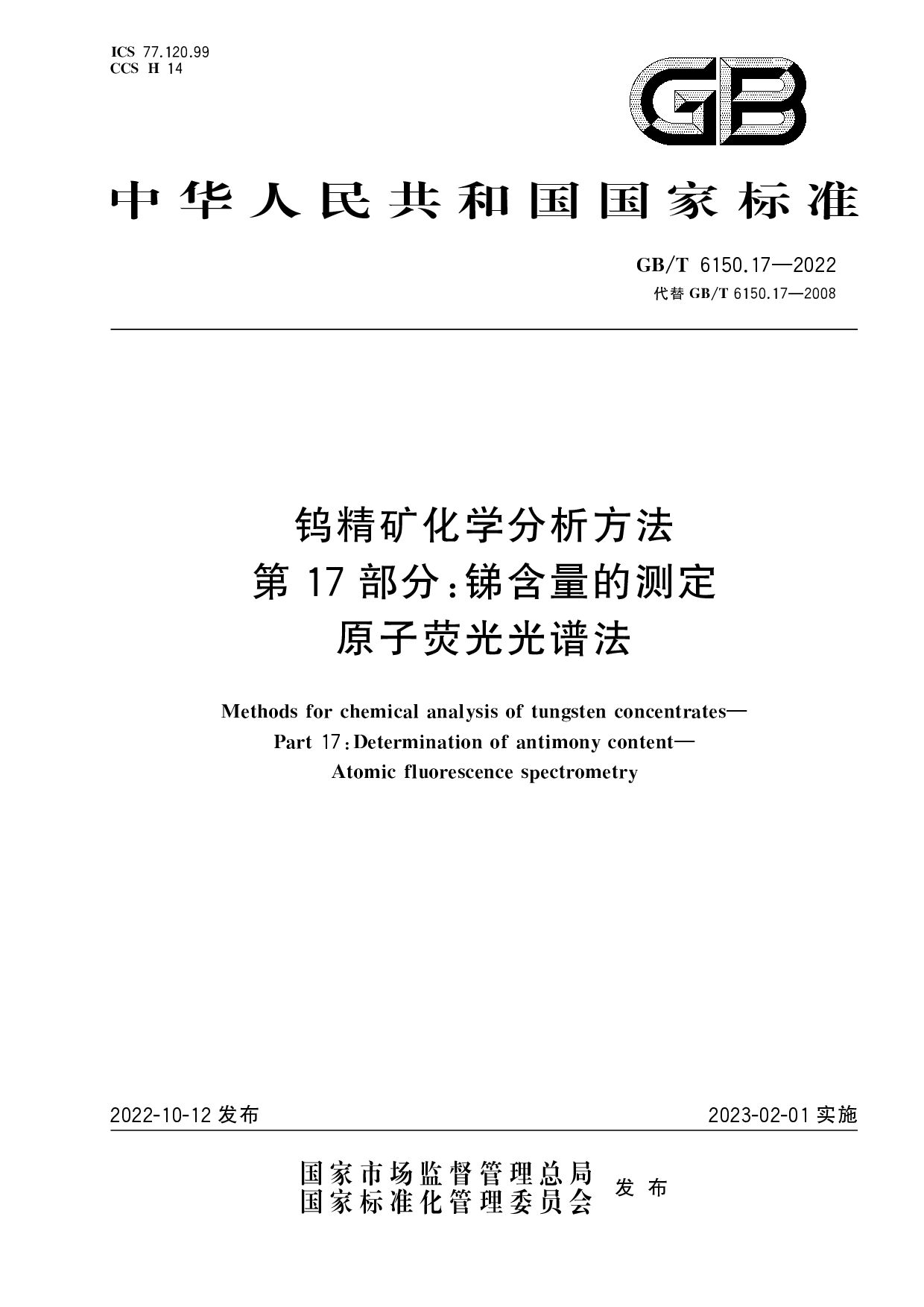GB/T 6150.17-2022
Methods for chemical analysis of tungsten concentrates—Part 17:Determination of antimony content—Atomic fluorescence spectrometry (English Version)

- Standard No.
- GB/T 6150.17-2022
- Language
- Chinese, Available in English version
- Release Date
- 2022
- Published By
- General Administration of Quality Supervision, Inspection and Quarantine of the People‘s Republic of China
- Latest
- GB/T 6150.17-2022
- Replace
- GB/T 6150.17-2008
- Scope
- This document specifies the method for the determination of antimony content in tungsten concentrates. This document is applicable to the determination of antimony content in tungsten concentrate, the determination range (mass fraction): 0.0010% ~ 0.20%.
- Introduction
Analysis of core changes in standards
Technical indicators GB/T6150.17-2008 GB/T6150.17-2022 Upgrade benefits Detection method Hydride atomic absorption spectrometry Atomic fluorescence spectrometry Detection limit reduced from 0.002% to 0.001% Precision control Allowable difference management Systematic reproducibility indicators Meet ISO17025 certification requirements
Key instrument technical specifications
The atomic fluorescence spectrometer used must meet the following requirements:
- Detection limit:≤1ng/mL
- Curve linearity:R²≥0.90
- Environmental adaptability:Acid and alkali gas corrosion resistant design
Precision control requirements
Antimony content range (%) Repeatability limit (r) Reproducibility limit (R) 0.0010-0.008 ±0.0013 ±0.0025 0.04-0.06 ±0.005 ±0.011 Note: The inter-laboratory comparison data comes from 72 hours of continuous testing by 8 authoritative institutions
Highlights of test process optimization
- Pretreatment speed-up: The sulfuric acid-ammonium sulfate mixed system is used to shorten the sample decomposition time by 35%
- Interference treatment: The citric acid complexation combined with thiourea system improves the efficiency of removing iron and manganese interference by 60%
Application verification case
A testing room tested the 0.15% antimony standard sample 10 times in a row:
- Range value <0.02% (MAS limit 0.03%)
- RSD<0.8% (better than the international EP specification 1.5%)
New standard practice guidance
Implementation phase Key control points Laboratory modification Need to be equipped with silicon carbide heating module for heating digestion device Staff training Focus on the control of hydride formation under non-equilibrium conditions
GB/T 6150.17-2022 Referenced Document
- GB/T 6682 Water for analytical laboratory use.Specification and test methods
- GB/T 8170 Rules of rounding off for numerical values & expression and judgement of limiting values
GB/T 6150.17-2022 history
- 2022 GB/T 6150.17-2022 Methods for chemical analysis of tungsten concentrates—Part 17:Determination of antimony content—Atomic fluorescence spectrometry
- 2008 GB/T 6150.15-2008 Methods for chemical analysis of tungsten concentrates.Determination of bismuth content.Flame atomic absorption spectrometric method
- 1985 GB/T 6150.17-1985 Methods for chemical analysis of tungsten concentrates--The semi-xylenol orange photometric method for the determination of bismuth content
GB/T 6150.17-2022 -All Parts
GB/T 6150.1-2023 Methods for chemical analysis of tungsten concentrates Part 1: Determination of tungsten trioxide content Ammonium tungstate ignition gravimetric method
GB/T 6150.10-2023 Methods of chemical analysis of tungsten concentrates - Part 10: Determination of lead content by hydride generation atomic fluorescence spectrometry and flame atomic absorption spectrometry
GB/T 6150.11-2008 Methods for chemical analysis of tungsten concentrates.Determination of zinc content.Flame atomic absorption spectrometric method
GB/T 6150.12-2023 Methods for chemical analysis of tungsten concentrates - Part 12: Determination of silica content by silicon molybdenum blue spectrophotometric and gravimetric methods
GB/T 6150.13-2022 Methods for chemical analysis of tungsten concentrates—Part 13:Determination of arsenic content—Atomic fluorescence spectrometry and the silver diethyldithiocarbamate(DDTC-Ag)spectrophotometry
GB/T 6150.14-2008 Methods for chemical analysis of tungsten concentrates.Determination of manganese content.The ammonium ferrous sulfate volumetric method and flame atomic absorption spectrometric method
GB/T 6150.15-2023 Methods for chemical analysis of tungsten concentrates - Part 15: Determination of bismuth content by hydride generation atomic fluorescence spectrometry and flame atomic absorption spectrometry
GB/T 6150.16-2009 Methods for chemical analysis of tungsten concentrates.Determination of iron content.The sulfosalicylic acid spectrophotometry
GB/T 6150.17-2022 Methods for chemical analysis of tungsten concentrates—Part 17:Determination of antimony content—Atomic fluorescence spectrometry
GB/T 6150.18-2023 Methods of chemical analysis of tungsten concentrates - Part 18: Determination of barium content by inductively coupled plasma atomic emission spectrometry
GB/T 6150.19-2025 Chemical analysis methods for tungsten concentrates - Part 19: Determination of fluorine content - Ion selective electrode method
GB/T 6150.2-2022 Methods for chemical analysis of tungsten concentrates—Part 2: Determination of tin content—Potassium iodate titrimetry and inductively coupled plasma atomic emission spectrometry
GB/T 6150.20-2025 Chemical analysis methods for tungsten concentrates. Part 20: Determination of mercury content. Direct determination method using solid sampling.
GB/T 6150.3-2023 Methods for chemical analysis of tungsten concentrates Part 3: Determination of phosphorus content Phosphomolybdenum yellow spectrophotometry and inductively coupled plasma atomic emission spectrometry
GB/T 6150.4-2023 Methods of chemical analysis of tungsten concentrates-Part 4: Determination of sulfur content by high-frequency induction infrared absorption method and combustion-iodometric method
GB/T 6150.5-2008 Methods for chemical analysis of tungsten concentrates.Determination of calcium content .EDTA volumetric method and flame atomic absorption spectrometric method
GB/T 6150.6-2023 Methods of Chemical Analysis of Tungsten Concentrates Part 6: Gravimetric Method for Determination of Wet Water Content
GB/T 6150.7-2008 Methods for chemical analysis of tungsten concentrates.Determination of tantalum content and niobium content.Inductively coupled plasma emission spectrometry and spectrophotometry
GB/T 6150.8-2023 Methods of chemical analysis of tungsten concentrates - Part 8: Determination of molybdenum content by thiocyanate spectrophotometric method
GB/T 6150.9-2009 Methods for chemical analysis of tungsten concentrates.Determination of copper content.Flame atomic absorption spectrometry